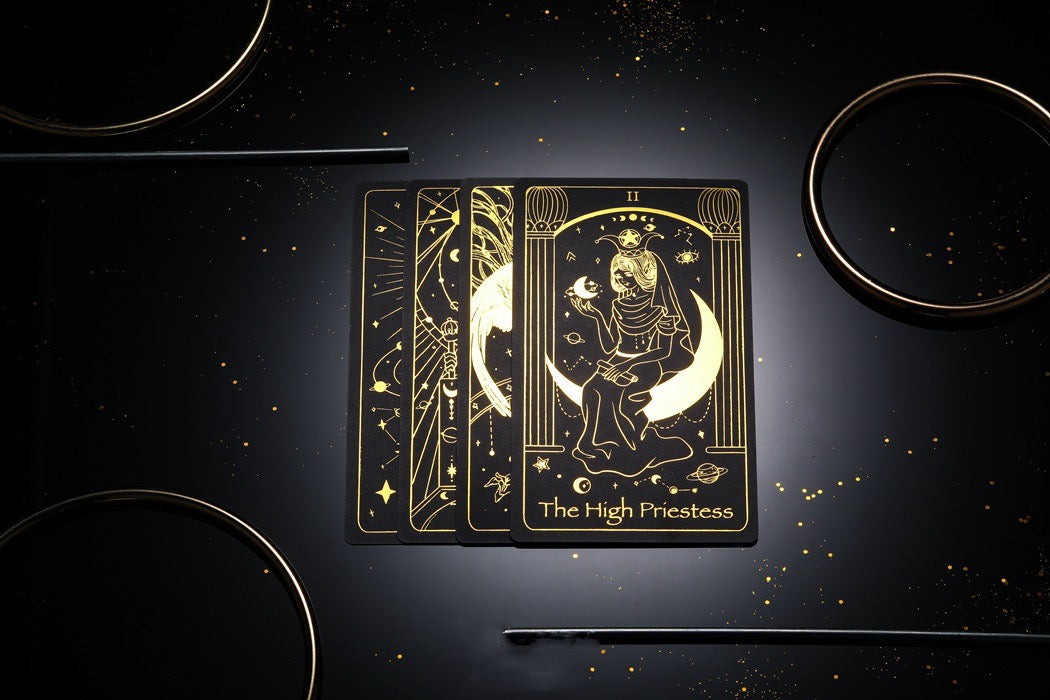Getting into tarot can be overwhelming at first. Here’s an easy seven step guide:
-
You start with choosing a deck that resonates with you
There are a few key differences between a regular deck of cards and a tarot deck. Generally, tarot decks contain more cards, and each card features an illustration associated with its meaning. The decks have been reimagined many times with different styles and themes.
The most important thing is that your tarot deck resonates with you: Buy a deck you’ll want to use and practice with. (Or, ask someone to buy a nice deck for you, if you feel superstitious about buying your own.)
At Azura Magic we hope that the design and quality of The Golden Path (Gold Foil Edition) tarot deck will call to your inner spirit.
-
Understand the basics of a tarot deck
A tarot deck has 78 cards and is divided into two sections: major arcana (major mysteries) and minor arcana (meaning minor mysteries).
There are 22 major arcana cards, and they tend to deal with big life events and overarching themes, for example, relationships, career and love.
There are 56 minor arcana cards. These tend to deal with smaller issues and day-to-day tribulations, like fleeting emotions and situations. Minor arcana cards are divided into four suits: cups, wands, swords and pentacles. Each suit has numbered cards from 1 through 10, as well as four court cards (page, knight, king and queen).
-
Come up with question you want to ask
The aim of a tarot reading is to explore a question about the self. You pick cards to help you reflect on possible answers, interpreting the meaning of each in relation to what you asked. Keep in mind that tarot cards are tools for introspection, and for that reason it’s best to keep questions open-ended.
-
Prepare your area
Do whatever feels right to set the mood. Some people like to use specific table cloths while they read, while others use candles or crystals.
-
Shuffling and cutting
After initial shuffling, place the deck facedown and cut it into multiple smaller decks. They don’t have to be of equal size — just whatever feels right. Then, restack all of the decks back together at random. Your cards are now ready to pull: You’ll flip individual cards up from the deck and place them faceup on the table.
-
Pull the cards
There are different ways to pull tarot cards. You pull them intuitively or into “spreads” — specific arrangement where each card is assigned a meaning.
-
Begin to learn and read the tarot deck
First up, the minor arcana. Cups, associated with water, is the suit that deals primarily with emotions, openness and imagination. Wands, associated with fire and passion, represent energy, movement and creative force. Swords, associated with air, represent your mind; how you think, communicate and solve problems. Pentacles, associated with earth, explore the physical world and how we interact with it, representing topics like money, the home and careers.
Next, the court cards. Just like in a regular deck of cards, each suit has face or court cards — usually called king, queen, page and knight.
Major arcana cards, like the Star or the Lovers, refer to bigger events in your life. Though these cards can be intimidating at first, just make sure to take your time with them and read up on all the different ways they can be interpreted. They’re always more nuanced than they seem at a glance: For example, while pulling the Death card may feel like a bad omen, it could be interpreted more innocently — that something in your life could end.


